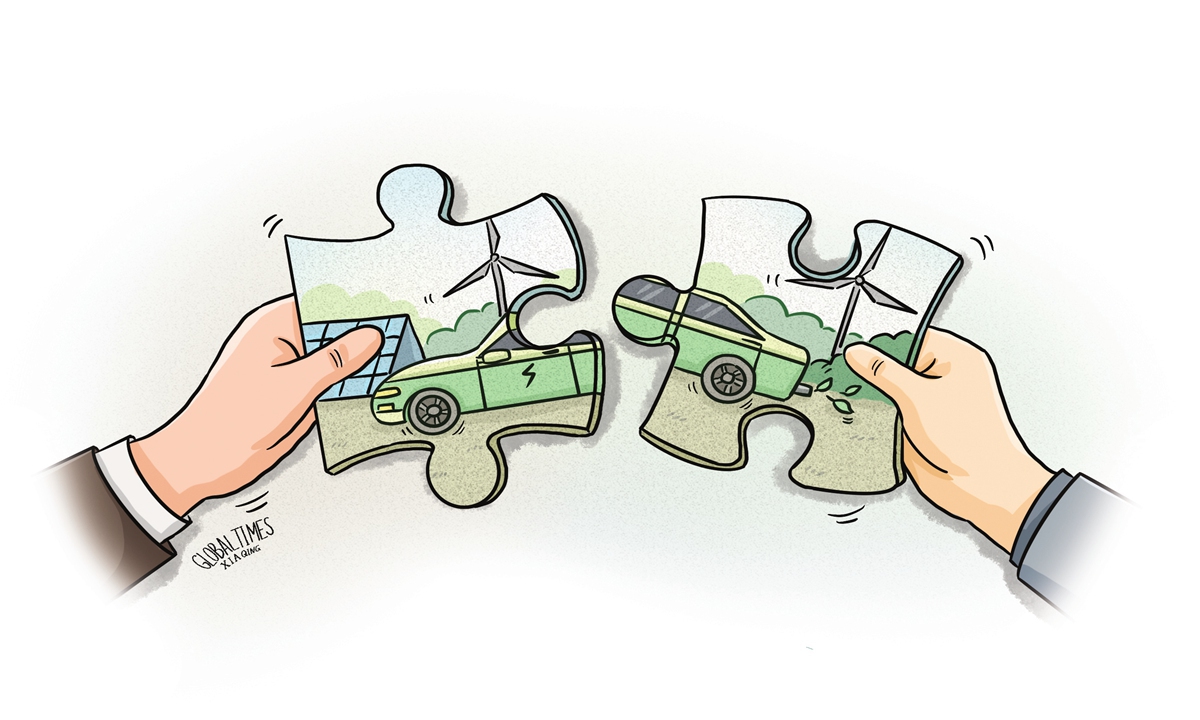
Illustration: Xia Qing/GT
Economic and trade cooperation between China and the EU in terms of the electric vehicle (EV) supply chain is entering an unprecedentedly complex and sensitive phase. Every related development seems to have the potential to spark widespread discussion.
In this landscape, where challenges and opportunities coexist, the key lies in whether both China and the EU can uphold the principles of pragmatism and balance to reach a solution. This is not only a test of both sides' wisdom but also a cornerstone for ensuring their mutual interests and fostering the healthy development of the global EV sector.
The EU is planning to force Chinese companies to transfer intellectual property to European businesses in return for EU subsidies as part of a tougher trade regime for clean technologies, the Financial Times reported on Tuesday, citing two senior EU officials.
New criteria requiring Chinese businesses to have factories in Europe and share technological knowhow will be introduced when Brussels invites bids for 1 billion euros ($1.05 billion) of grants to develop batteries in December. The pilot could be rolled out to other EU subsidy programs, they said.
It remains uncertain and there is no concrete evidence indicating whether the EU will really include criteria requiring Chinese companies to transfer technology in its subsidy program. Even if such criteria are introduced, it is important to note that they would not constitute legally binding mandatory regulations or provisions. This means Chinese companies, when faced with such criteria, would retain the right to make the most appropriate decisions based on their strategic interests, market considerations and principles of technology protection.
The EV issue has become a particularly sensitive topic, prone to friction, in China-EU economic and trade cooperation. In this context, the EU's message regarding technology transfer may be a tactical test aimed at observing China's response and assessing both sides' bottom lines and flexibility on this issue. Such an approach could serve as a prelude to policy formulation or an effort by the EU to seek new possibilities and expand the space for industrial development.
Chinese companies have made significant progress in EV-related technologies, not only occupying a leading position in the domestic market but also actively seeking to expand into overseas markets.
The EU aims to accelerate the development of the EV sector in order to achieve its green transformation goals, which will require support from advanced battery technology and EV manufacturing capacity. In this sense, cooperation potential between China and the EU in the EV sector is enormous and mutually beneficial, with both sides having a strong demand for collaboration.
Therefore, although the report regarding the EU's technology transfer issue may raise concerns and uncertainties, there is no reason to adopt a pessimistic outlook on the potential for China-EU cooperation.
This situation presents both sides with an opportunity to strengthen communication, enhance mutual understanding and establish a more solid foundation for collaboration. In view of the China-EU consultation on the issue of EVs, continuous communication and understanding of each other's concerns is very important.
In the process of connecting companies and markets between China and the EU, it is normal to see friction. However, a path for connection will inevitably be found through mutual concessions.
Negotiation is essentially a process of bargaining. If both sides really reach the stage of discussion, it indicates that both sides are trying to find a balance of interests through bargaining. This can be seen as progress. At the very least, the EU can no longer simply use tariffs to block Chinese EVs from entering Europe.
From November 2 to 7, technical teams from China and the EU conducted five rounds of consultations regarding the price commitment proposal in the EU's anti-subsidy cases on China-made EVs, and certain progress was achieved, the Ministry of Commerce announced in an online statement on November 8. Both sides agreed to continue consultations via video or other means.
This indicates that both parties are willing to resolve their differences through cooperation and negotiation, which is a positive signal. Only through continuous dialogue and communication can both parties eliminate misunderstandings and doubts, jointly advancing cooperation in the EV sector.
However, to truly reach a mutually acceptable solution, both sides need to promote trade, technology and industrial cooperation based on fair market mechanisms by upholding the principles of pragmatism and balance. Cooperation between China and EU in the EV sector still represents a win-win situation, and it is worth the efforts of both sides to achieve it.




